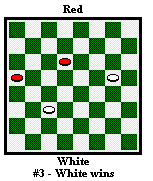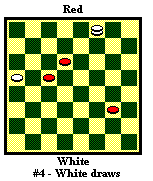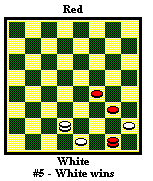 In diagram
#1, the Red piece on 22 is immobile. White wins simply with 5-1 20-24 1-6 24-27
6-9 27-31 9-14 31-27 14-18 (not 14-17? RW) WW.
In diagram
#1, the Red piece on 22 is immobile. White wins simply with 5-1 20-24 1-6 24-27
6-9 27-31 9-14 31-27 14-18 (not 14-17? RW) WW. Return to my Checkers pages
Go to my home page
Copyright 1997, Jim Loy
You may print this and show it to others. But, this article will eventually be
part of a book that I am writing. So, please do not distribute it widely.
If you need help reading checkers notation, please print out the numbered board.
When a piece is immobile, you can often win it by attacking it from behind, with a king. You may immobilize the piece early in the game, and then finish it off much later, in the ending. The following positions have been simplified, for clarity. Normally, you will see extra pieces all around.
 In diagram
#1, the Red piece on 22 is immobile. White wins simply with 5-1 20-24 1-6 24-27
6-9 27-31 9-14 31-27 14-18 (not 14-17? RW) WW.
In diagram
#1, the Red piece on 22 is immobile. White wins simply with 5-1 20-24 1-6 24-27
6-9 27-31 9-14 31-27 14-18 (not 14-17? RW) WW.
 In diagram
#2, the piece on 14 is immobile: 11-7 & 7-2 & 2-6 & 6-9 WW.
In diagram
#2, the piece on 14 is immobile: 11-7 & 7-2 & 2-6 & 6-9 WW.
 In diagram
#3, White immobilizes the piece on 10 with 22-18 13-17 16-12 (16-11? 10-15
draw) 17-22 12-8 22-26 8-3 26-31 3-7 WW.
In diagram
#3, White immobilizes the piece on 10 with 22-18 13-17 16-12 (16-11? 10-15
draw) 17-22 12-8 22-26 8-3 26-31 3-7 WW.
 In diagram
#4, White immobilizes Red's pair of pieces, with 3-7. Then he goes on to win
one of them: 24-27 13-9 27-31 9-5 31-26 5-1 26-22 1-6 to draw. Black can never
escape with 10-15, because of the fork 7-10.
In diagram
#4, White immobilizes Red's pair of pieces, with 3-7. Then he goes on to win
one of them: 24-27 13-9 27-31 9-5 31-26 5-1 26-22 1-6 to draw. Black can never
escape with 10-15, because of the fork 7-10.
 In diagram
#5, White has a win with 26-22 32-27 22-17 (Not 22-18? 19-23! 28-19 27-32 18-27
32-16 RW!) 27-23 17-14 23-27 14-10 27-23 10-15 23-27 15-11 27-23 11-16 WW.
In diagram
#5, White has a win with 26-22 32-27 22-17 (Not 22-18? 19-23! 28-19 27-32 18-27
32-16 RW!) 27-23 17-14 23-27 14-10 27-23 10-15 23-27 15-11 27-23 11-16 WW.
Your opponent may have a doomed, immobile piece, early in the game. And it may take you many moves to king a piece, and get this king to the right part of the board, to attack the immobile piece. But you knew you had a win, all along. You may be accused of seeing 40 or 50 moves ahead.